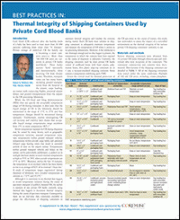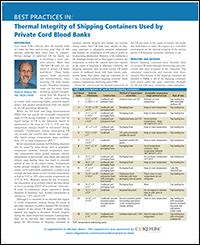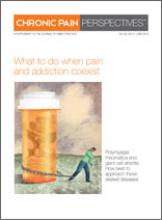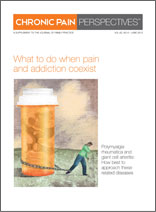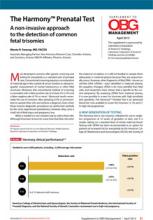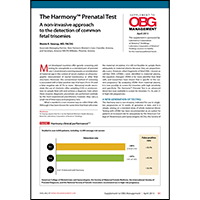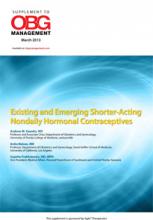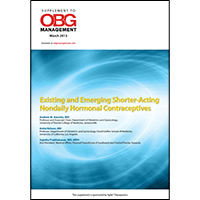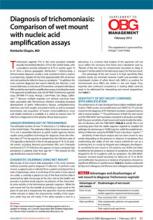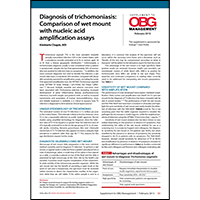User login
BEST PRACTICES IN: Thermal Integrity of Shipping Containers Used by Private Cord Blood Banks
A supplement to Ob.Gyn. News. This supplement was sponsored by CORD:USE Cord Blood Bank, Inc.
• Introduction
• Materials and methods
• Results
• Discussion
Faculty/Faculty Disclosure
Robert N. Wolfson, MD, PhD, FACOG, FAIUM
Specialists in Women’s Health, LLC
Colorado Springs, Colorado
Dr Wolfson has nothing to disclose.
Copyright ©2013 by Frontline Medical Communications Inc.
A supplement to Ob.Gyn. News. This supplement was sponsored by CORD:USE Cord Blood Bank, Inc.
• Introduction
• Materials and methods
• Results
• Discussion
Faculty/Faculty Disclosure
Robert N. Wolfson, MD, PhD, FACOG, FAIUM
Specialists in Women’s Health, LLC
Colorado Springs, Colorado
Dr Wolfson has nothing to disclose.
Copyright ©2013 by Frontline Medical Communications Inc.
A supplement to Ob.Gyn. News. This supplement was sponsored by CORD:USE Cord Blood Bank, Inc.
• Introduction
• Materials and methods
• Results
• Discussion
Faculty/Faculty Disclosure
Robert N. Wolfson, MD, PhD, FACOG, FAIUM
Specialists in Women’s Health, LLC
Colorado Springs, Colorado
Dr Wolfson has nothing to disclose.
Copyright ©2013 by Frontline Medical Communications Inc.
Clinical Utility of Low-Density Lipoprotein Particles and Apolipoprotein B in Patients with Cardiovascular Risk
Chronic Pain Perspectives – June 2013
Best Practices in IVF Nursing: National Nurses Week, May 6-12, 2013: Four IVF nurses share compelling stories of joys, tears, and determination
We have witnessed rapid and impressive changes in the delivery of IVF care in just 2 decades. However, the monumental change in the nursing profession in general is often overlooked or forgotten
We have witnessed rapid and impressive changes in the delivery of IVF care in just 2 decades. However, the monumental change in the nursing profession in general is often overlooked or forgotten
We have witnessed rapid and impressive changes in the delivery of IVF care in just 2 decades. However, the monumental change in the nursing profession in general is often overlooked or forgotten
The Harmony™ Prenatal Test: A non-invasive approach to the detection of common fetal trisomies
Chronic Pain Perspectives - March 2013
Existing and Emerging Shorter-Acting Nondaily Hormonal Contraceptives
Best Practices in IVF Nursing Egg banking: Advances in cryopreservation increase availability of donor eggs, enhance reproductive options for women
Steering patients to relief from chronic low back pain: Opioids’ role
The author reported no potential conflict of interest relevant to this article.
Mr. S, age 57, recalls no specific event that triggered his lower back pain, which began 2 years ago and has been gradually worsening. His pain improves at times and varies in severity day to day. At this visit, he rates the pain as a 7 on a 10-point scale. The pain now interferes with his ability to walk more than 2 to 3 blocks, and when he golfs on weekends, he must now ride in the golf cart. Mr. S describes himself as fortunate, as his back pain has not interfered with his job as an engineer.
Mr. S has no associated leg pain or other neurologic symptoms. Radiography of the lumbosacral spine shows degenerative disc disease and facet joint arthritis. He has tried acetaminophen, then prescription-strength nonsteroidal anti-inflammatory drugs (NSAIDs) and supervised exercise therapy. He asks you about an opioid prescription.
Is it time to prescribe opioids?
Up to 70% of people experience a low back pain episode at least once in their lifetime, making low back pain among the most common conditions encountered in clinical practice.1 Low back pain can impair function, ability to work, and quality of life, and it frequently is associated with depression or anxiety.2,3
Physicians prescribe medications more than any other treatments for low back pain.4 The analgesic arsenal includes acetaminophen, NSAIDs, opioids, antidepressants, skeletal muscle relaxants, benzodiazepines, anticonvulsants, and others.
The good news for people with acute low back pain is that the natural history is quite favorable: most improve within the first 4 weeks.5 The key components of early treatment are self-care education, advice to stay active, and simple analgesics (acetaminophen and NSAIDs). Opioids may be appropriate for time-limited symptomatic relief for selected patients with severe pain,6 but no randomized trials have examined opioids for acute low back pain.
The treatment approach is less definitive for individuals such as Mr. S with chronic low back pain (generally defined as >12 weeks’ duration). Opioids are commonly prescribed and are the most potent analgesics,7 but they are associated with abuse potential and other adverse effects, such as constipation, nausea, and sedation. Furthermore, opioids’ clinical benefits for low back pain may be limited, particularly when prescribed for long-term use.8
Few studies inform opioid use in low back pain
Two systematic reviews published in 2007 found few placebo-controlled randomized trials of opioids for chronic low back pain, with some trials showing no analgesic benefit of opioids over placebo and no clear evidence of improved function.9,10 Two subsequent trials showed moderate benefits of opioids for chronic low back pain—1.5 to 2 points on a 10-point pain scale—compared with placebo.11,12
Observational studies from workers’ compensation settings suggest that opioid use by people with low back pain may worsen outcomes. A cohort study using a Washington State administrative database found poorer function associated with higher opioid doses over time.13 Although these investigators applied statistical adjustments for potential confounders, residual confounding probably remained because individuals who were more likely to have poor outcomes may also have been more likely to receive higher opioid doses.
A greater body of evidence exists on the use of opioids for other types of chronic pain, such as osteoarthritis or rheumatoid arthritis. A systematic review found approximately 20% to 30% greater pain relief for noncancer chronic pain from opioids compared with placebo during short-term treatment (average 5 weeks).14 These results may reasonably extrapolate to estimated benefits from opioids for chronic low back pain, which probably wouldn’t respond differently than other types of chronic pain.
Guidelines call for a multifaceted approach
Given the limited evidence and potential for adverse effects, guidelines from the American College of Physicians and American Pain Society (ACP/APS) recommend opioids as part of an overall approach to managing low back pain.6
First-line therapy. The ACP/APS guidelines recommend using acetaminophen and NSAIDs as first-line pharmacologic treatment for low back pain.6 Although less potent than opioids, these analgesics offer a more favorable balance of benefits to harms.15 Acetaminophen is associated with liver toxicity and NSAIDs with gastrointestinal bleeding and cardiovascular events, but we can mitigate these risks by avoiding use in people with contraindications and prescribing lower doses for the shortest duration necessary.
The guidelines also recommend an emphasis on self-care, in particular advising people to remain active.6 This message has been shown to be more effective than prescribed bed rest in helping individuals with low back pain return to normal function.16 For chronic low back pain, exercise therapy remains a key intervention with added health benefits. Effective programs focus on core strengthening, flexion/extension movements, directional preference, aerobic fitness, mind-body exercises (such as yoga and Pilates), and other techniques.17 Some evidence suggests that >20 hours of intervention time is more effective than less intensive exercise therapy.18
Exercise therapy remains a key intervention for low back pain.
Other options. Medication options for individuals who do not respond adequately to acetaminophen and NSAIDs include short-term skeletal muscle relaxants for acute low back pain and antidepressants for chronic low back pain.6 Skeletal muscle relaxants are not considered first-line medications because of their high rate of sedation, and they have not been studied well in chronic low back pain. The serotonin norepinephrine reuptake inhibitor duloxetine was FDA approved recently for treating chronic low back pain and appears to have modest effects on pain and function.19
Complementary and alternative modalities such as spinal manipulation, acupuncture, and massage also are recommended for chronic low back pain, but not as substitutes for exercise therapy.6 Psychotherapy is another option, especially for patients with difficulty coping or comorbid psychiatric conditions. Physical modalities such as ultrasound, transcutaneous electrical nerve stimulation, and interferential therapy are not recommended because of a lack of evidence showing benefits.6 The role of interventional therapies and surgery is limited for low back pain without evidence of radiculopathy due to herniated disc or spinal stenosis.20
Opioids. In general, reserve opioids for individuals who do not respond to first-line medications and nonpharmacologic therapies. Earlier consideration of opioids may be warranted for people with severe pain and functional limitations or contraindications to first-line medications.
To manage chronic low back pain effectively, be clear with patients that opioids generally do not eliminate pain and, if used, are one part of an overall management plan. The benefits of using opioids are not likely to exceed—and might well be less than—the average 20% to 30% pain relief observed in clinical trials for general chronic pain.
Managing biopsychosocial components. For many individuals, chronic low back pain is best understood as a complex biopsychosocial condition.21 Cognitive behavioral therapy can be helpful for those with severe functional limitations related to low back pain or maladaptive coping strategies. They may exhibit fear avoidance (avoiding usual activities out of fear of harming the back) or catastrophizing (dwelling on the worst possible outcome of the back pain, such as total disability).22-24 Depression also is common with low back pain and should be appropriately evaluated and treated.16
For injured workers, opioid therapy is most likely to be effective when used in conjunction with cognitive behavioral therapy, exercise therapy, and functional restoration. Functional restoration is an intervention that includes simulated or actual work tests in a supervised environment to enhance job performance skills and improve strength, endurance, flexibility, and cardiovascular fitness.
Assess risks/benefits when considering opioids
An American Pain Society/American Academy of Pain Medicine (APS/AAPM) guideline on opioid therapy for chronic low back pain or other types of pain emphasizes the need to assess risks related to opioids’ abuse potential and to consider potential benefits and other adverse effects, such as increased respiratory depression in individuals with obstructive sleep apnea or increased risk of falls and fractures in older patients.25
Major risk factors for opioid misuse or abuse include a personal or family history of substance abuse—the latter often overlooked but critical. Formal tools such as the Opioid Risk Tool (TABLE) can help you perform and document risk assessment.26 The Opioid Risk Tool categorizes patients as low-, moderate-, or high-risk for aberrant drug-related behaviors, based on a simple point system using 5 criteria.
Risk assessment informs your decisions about whether to start opioids and how to structure follow-up and monitoring. For example, you may deem a higher-risk patient inappropriate for opioids and instead focus on functional restoration, cognitive behavioral therapy, and nonopioid analgesics. Alternatively, you might consider opioids, but only in conjunction with other therapies and with more intense monitoring and follow-up to mitigate potential risks. This plan might include more frequent clinic visits, limited-duration prescription refills (such as a 1 or 2 weeks’ supply instead of 1 month), frequent random urine drug screens,27 and close follow-up of prescription drug monitoring program data. (See “How to avoid opioid misuse”.)
TABLE
Opioid Risk Tool: Assessing opioid abuse potential
| Mark each box that applies | Female | Male | |
|---|---|---|---|
| 1. Family history of substance abuse | |||
| Alcohol | ▢ 1 | ▢ 3 | |
| Illegal drugs | ▢ 2 | ▢ 3 | |
| Prescription drugs | ▢ 4 | ▢ 4 | |
| 2. Personal history of substance abuse | |||
| Alcohol | ▢ 3 | ▢ 3 | |
| Illegal drugs | ▢ 4 | ▢ 4 | |
| Prescription drugs | ▢ 5 | ▢ 5 | |
| 3. Age (mark if between 16-45 years) | ▢ 1 | ▢ 1 | |
| 4. History of preadolescent sexual abuse | ▢ 3 | ▢ 0 | |
| 5. Psychological disease | |||
| ADD, OCD, bipolar, schizophrenia | ▢ 2 | ▢ 2 | |
| Depression | ▢ 1 | ▢ 1 | |
| Scoring totals | _______ | _______ | |
| 0–3=low risk for aberrant behaviors; 4–7=moderate risk; ≥8=high risk. | |||
| ADD, attention-deficit disorder; OCD, obsessive-compulsive disorder. From Webster LR, Webster RM. Pain Med. 2005.26 Used with permission. | |||
Start low
The APS/AAPM guideline recommends that you initiate opioids at low doses (such as hydrocodone 5-10 mg, codeine 60 mg, or oxycodone 5 mg, 2 to 3 times daily) and titrate slowly to reduce the risk of accidental overdose.25 Previously, physicians prescribed opioids with no “ceiling dose,” meaning that doses were titrated up until patients experienced pain relief or intolerable adverse effects. Recent evidence, however, indicates that the risk of overdose in patients prescribed opioids for chronic pain begins to increase at doses equivalent to morphine, 50 to 100 mg/day, and continues to rise in a dose-dependent fashion.28-30
The risk of overdose begins to increase at doses equivalent to morphine, 50 to 100 mg/day, and continues to rise in a dose-dependent fashion.
Studies are not yet available to show whether patients who do not respond at morphine-equivalent doses <50 to 100 mg/day will respond at higher doses. Anecdotally, however, many patients who do not respond at lower doses also do not appear to respond at higher doses of the same opioid, or respond minimally. Therefore, prescribe opioids at doses equivalent to morphine >100 mg/day only for patients with clearly demonstrated improvement in pain and function whom you can adequately monitor.
Include these in the treatment plan
As part of the treatment plan, be sure to define measurable, achievable functional goals for all patients to help assess benefits from opioids. For example, walking the dog for 20 minutes 5 times a week is a feasible and measurable functional goal for a 60-year-old patient, whereas a goal to “feel 25 years old again” is not.
Define measurable, achievable functional goals to help assess benefits from opioids.
Always have an “exit strategy” when starting opioids, with a clear understanding of circumstances that will lead to opioid discontinuation (such as inability to take opioids as prescribed, noncompliance with other recommended interventions or follow-up, or illicit drug use) as well as a plan on how to taper opioids, including resources for managing withdrawal. Outline this opioid management plan in writing, including reasons for discontinuation, making the treatment parameters clear to the patient and other health care providers from the onset.
CASE
Mr. S has no personal or family history of substance abuse, no history of depression or other psychological disorders, and no serious comorbid conditions that are contraindications to opioid therapy. He scores 0 points on the Opioid Risk Tool, and a urine drug screen is negative. You initiate low-dose opioid therapy (oxycodone 5 mg 3 times daily as needed). You set a goal that Mr. S walk 30 minutes 4 times a week, with a longer-term goal of walking 9 holes of golf.
Continually reassess
Consider the period after you initiate opioids as a treatment trial, and constantly reexamine the decision to continue opioids.25 In follow-up, carefully assess for pain and functional status as well as signs of aberrant drug-related behaviors or other adverse effects.
When a patient is not benefiting from opioids in terms of reduced pain and improved function or is experiencing adverse effects, consider whether to discontinue or restructure opioid therapy. You might try a lower dose, intensify monitoring, consider a specialty consultation, or take other measures. Importantly, patients who are discontinued from opioids still need help to manage their pain, as well as withdrawal symptoms and addiction (when present). They frequently benefit from interventions designed to improve function and address psychological comorbidities and maladaptive coping strategies. Options include psychologically informed physical therapy, interdisciplinary rehabilitation, and cognitive behavioral therapy.
Patients who are discontinued from opioids still need help to manage their pain.
CASE
At follow-up in 4 weeks, Mr. S reports his pain level has gone down from an average of 7 out of 10 to 4 out of 10, and he has been able to walk 20 to 30 minutes 4 times a week. He has no signs of aberrant behaviors. You decide to continue opioid therapy at the same low dose and reiterate the importance of reaching and maintaining functional goals. At this point, you plan to continue the opioid medication as long as he shows continued improvement in functionality and has no signs of aberrant behaviors. You schedule the next follow-up visit in 8 weeks.
1. Koes BW, van Tulder MW, Thomas S. Diagnosis and treatment of low back pain. BMJ. 2006;332:1430-1434.
2. Bair MJ, Robinson RL, Katon W, et al. Depression and pain comorbidity. Arch Intern Med. 2003;163:2433-2445.
3. Martin BI, Deyo RA, Mirza SK, et al. Expenditures and health status among adults with back and neck problems. JAMA. 2008;299:656-664.
4. Cherkin DC, Wheeler KJ, Barlow W, et al. Medication use for low back pain in primary care. Spine. 1998;23:607-614.
5. Pengel LHM, Herbert RD, Maher CG, et al. Acute low back pain: systematic review of its prognosis. BMJ. 2003;327:323-327.
6. Chou R, Qaseem A, Snow V, et al. Diagnosis and treatment of low back pain: a joint clinical practice guideline from the American College of Physicians and the American Pain Society. Ann Intern Med. 2007;147:478-491.
7. Deyo RA, Smith DH, Johnson ES, et al. Opioids for back pain patients: primary care prescribing patterns and use of services. J Am Board Fam Med. 2011;24:717-727.
8. Von Korff M, Kolodny A, Deyo RA, Chou R. Long-term opioid therapy reconsidered. Ann Intern Med. 2011;155:325-328.
9. Deshpande A, Furlan A, Mailis-Gagnon A, et al. Opioids for chronic low-back pain. Cochrane Database of Systematic Reviews. 2007(3):CD004959.-
10. Martell BA, O’Connor PG, Kerns RD, et al. Systematic review: Opioid treatment for chronic back pain: prevalence, efficacy, and association with addiction. Ann Intern Med. 2007;146:116-127.
11. Hale ME, Ahdieh H, Ma T, Rauck R. Efficacy and safety of Opana ER (oxymorphone extended release) for relief of moderate to severe chronic low back pain in opioid-experienced patients: a 12-week, randomized, double-blind, placebo-controlled study. J Pain. 2007;8:175-184.
12. Katz N, Richard R, Harry A, et al. A 12-week, randomized, placebo-controlled trial assessing the safety and efficacy of oxymorphone extended release for opioid-naive patients with chronic low back pain. Curr Med Res Opin. 2007;23:117-128.
13. Franklin GM, Enass R, Turner JA, et al. Opioid use for chronic low back pain: a prospective, population-based study among injured workers in Washington state, 2002-2005. Clin J Pain. 2009;25:743-751.
14. Furlan AD, Sandoval JA, Mailis-Gagnon A, et al. Opioids for chronic noncancer pain: a meta-analysis of effectiveness and side effects. CMAJ. 2006;174:1589-1594.
15. Chou R, Huffman LH. Medications for acute and chronic low back pain: a review of the evidence for an American Pain Society/American College of Physicians clinical practice guideline. Ann Intern Med. 2007;147:505-514.
16. Chou R, Huffman LH. Non-pharmacologic therapies for acute and chronic low back pain: a review of the evidence for an American Pain Society/American College of Physicians clinical practice guideline. Ann Intern Med. 2007;147:492-504.
17. Hayden JA, van Tulder MW, Malmivaara AV, et al. Meta-analysis: exercise therapy for nonspecific low back pain. Ann Intern Med. 2005;142:765-775.
18. Hayden JA, van Tulder MW, Tomlinson G. Systematic review: strategies for using exercise therapy to improve outcomes in chronic low back pain. Ann Intern Med. 2005;142:776-785.
19. FDA clears Cymbalta to treat chronic musculoskeletal pain. Available at: http://www.fda.gov/NewsEvents/Newsroom/PressAnnouncements/ucm232708.htm. Accessed October 7, 2012.
20. Chou R, Loeser JD, Owens DK, et al. Interventional therapies, surgery and interdisciplinary rehabilitation for low back pain: an evidence-based clinical practice guideline from the American Pain Society. Spine. 2009;34:1066-1077.
21. Waddell G. Biopsychosocial analysis of low back pain. Baillieres Clin Rheumatol. 1992;6:523-557.
22. Chou R, McCarberg B. Managing acute back pain patients to avoid the transition to chronic pain. Pain Management. 2011;1:69-79.
23. Turner JA, Aaron LA. Pain-related catastrophizing: what is it? Clin J Pain. 2001;17:65-71.
24. Vlaeyen JW, Linton SJ. Fear-avoidance and its consequences in chronic musculoskeletal pain: a state of the art. Pain. 2000;85:317-332.
25. Chou R, Fanciullo G, Fine P, et al. Clinical guidelines for the use of chronic opioid therapy in chronic noncancer pain. J Pain. 2009;10:113-130.
26. Webster LR, Webster RM. Predicting aberrant behaviors in opioid-treated patients: preliminary validation of the Opioid Risk Tool. Pain Med. 2005;6:432-442.
27. Peppin JF, Passik SD, Couto JE, et al. Recommendations for urine drug monitoring as a component of opioid therapy in the treatment of chronic pain. Pain Med. 2012;13:886-896.
28. Bohnert AS, Valenstein M, Bair MJ, et al. Association between opioid prescribing patterns and opioid overdose-related deaths. JAMA. 2011;305:1315-1321.
29. Dunn KM, Saunders KW, Rutter CM, et al. Opioid prescriptions for chronic pain and overdose: a cohort study. Ann Intern Med. 2010;152:85-92.
30. Gomes T, Mamdani MM, Dhalla IA, et al. Opioid dose and drug-related mortality in patients with nonmalignant pain. Arch Intern Med. 2011;171:686-691.
The author reported no potential conflict of interest relevant to this article.
Mr. S, age 57, recalls no specific event that triggered his lower back pain, which began 2 years ago and has been gradually worsening. His pain improves at times and varies in severity day to day. At this visit, he rates the pain as a 7 on a 10-point scale. The pain now interferes with his ability to walk more than 2 to 3 blocks, and when he golfs on weekends, he must now ride in the golf cart. Mr. S describes himself as fortunate, as his back pain has not interfered with his job as an engineer.
Mr. S has no associated leg pain or other neurologic symptoms. Radiography of the lumbosacral spine shows degenerative disc disease and facet joint arthritis. He has tried acetaminophen, then prescription-strength nonsteroidal anti-inflammatory drugs (NSAIDs) and supervised exercise therapy. He asks you about an opioid prescription.
Is it time to prescribe opioids?
Up to 70% of people experience a low back pain episode at least once in their lifetime, making low back pain among the most common conditions encountered in clinical practice.1 Low back pain can impair function, ability to work, and quality of life, and it frequently is associated with depression or anxiety.2,3
Physicians prescribe medications more than any other treatments for low back pain.4 The analgesic arsenal includes acetaminophen, NSAIDs, opioids, antidepressants, skeletal muscle relaxants, benzodiazepines, anticonvulsants, and others.
The good news for people with acute low back pain is that the natural history is quite favorable: most improve within the first 4 weeks.5 The key components of early treatment are self-care education, advice to stay active, and simple analgesics (acetaminophen and NSAIDs). Opioids may be appropriate for time-limited symptomatic relief for selected patients with severe pain,6 but no randomized trials have examined opioids for acute low back pain.
The treatment approach is less definitive for individuals such as Mr. S with chronic low back pain (generally defined as >12 weeks’ duration). Opioids are commonly prescribed and are the most potent analgesics,7 but they are associated with abuse potential and other adverse effects, such as constipation, nausea, and sedation. Furthermore, opioids’ clinical benefits for low back pain may be limited, particularly when prescribed for long-term use.8
Few studies inform opioid use in low back pain
Two systematic reviews published in 2007 found few placebo-controlled randomized trials of opioids for chronic low back pain, with some trials showing no analgesic benefit of opioids over placebo and no clear evidence of improved function.9,10 Two subsequent trials showed moderate benefits of opioids for chronic low back pain—1.5 to 2 points on a 10-point pain scale—compared with placebo.11,12
Observational studies from workers’ compensation settings suggest that opioid use by people with low back pain may worsen outcomes. A cohort study using a Washington State administrative database found poorer function associated with higher opioid doses over time.13 Although these investigators applied statistical adjustments for potential confounders, residual confounding probably remained because individuals who were more likely to have poor outcomes may also have been more likely to receive higher opioid doses.
A greater body of evidence exists on the use of opioids for other types of chronic pain, such as osteoarthritis or rheumatoid arthritis. A systematic review found approximately 20% to 30% greater pain relief for noncancer chronic pain from opioids compared with placebo during short-term treatment (average 5 weeks).14 These results may reasonably extrapolate to estimated benefits from opioids for chronic low back pain, which probably wouldn’t respond differently than other types of chronic pain.
Guidelines call for a multifaceted approach
Given the limited evidence and potential for adverse effects, guidelines from the American College of Physicians and American Pain Society (ACP/APS) recommend opioids as part of an overall approach to managing low back pain.6
First-line therapy. The ACP/APS guidelines recommend using acetaminophen and NSAIDs as first-line pharmacologic treatment for low back pain.6 Although less potent than opioids, these analgesics offer a more favorable balance of benefits to harms.15 Acetaminophen is associated with liver toxicity and NSAIDs with gastrointestinal bleeding and cardiovascular events, but we can mitigate these risks by avoiding use in people with contraindications and prescribing lower doses for the shortest duration necessary.
The guidelines also recommend an emphasis on self-care, in particular advising people to remain active.6 This message has been shown to be more effective than prescribed bed rest in helping individuals with low back pain return to normal function.16 For chronic low back pain, exercise therapy remains a key intervention with added health benefits. Effective programs focus on core strengthening, flexion/extension movements, directional preference, aerobic fitness, mind-body exercises (such as yoga and Pilates), and other techniques.17 Some evidence suggests that >20 hours of intervention time is more effective than less intensive exercise therapy.18
Exercise therapy remains a key intervention for low back pain.
Other options. Medication options for individuals who do not respond adequately to acetaminophen and NSAIDs include short-term skeletal muscle relaxants for acute low back pain and antidepressants for chronic low back pain.6 Skeletal muscle relaxants are not considered first-line medications because of their high rate of sedation, and they have not been studied well in chronic low back pain. The serotonin norepinephrine reuptake inhibitor duloxetine was FDA approved recently for treating chronic low back pain and appears to have modest effects on pain and function.19
Complementary and alternative modalities such as spinal manipulation, acupuncture, and massage also are recommended for chronic low back pain, but not as substitutes for exercise therapy.6 Psychotherapy is another option, especially for patients with difficulty coping or comorbid psychiatric conditions. Physical modalities such as ultrasound, transcutaneous electrical nerve stimulation, and interferential therapy are not recommended because of a lack of evidence showing benefits.6 The role of interventional therapies and surgery is limited for low back pain without evidence of radiculopathy due to herniated disc or spinal stenosis.20
Opioids. In general, reserve opioids for individuals who do not respond to first-line medications and nonpharmacologic therapies. Earlier consideration of opioids may be warranted for people with severe pain and functional limitations or contraindications to first-line medications.
To manage chronic low back pain effectively, be clear with patients that opioids generally do not eliminate pain and, if used, are one part of an overall management plan. The benefits of using opioids are not likely to exceed—and might well be less than—the average 20% to 30% pain relief observed in clinical trials for general chronic pain.
Managing biopsychosocial components. For many individuals, chronic low back pain is best understood as a complex biopsychosocial condition.21 Cognitive behavioral therapy can be helpful for those with severe functional limitations related to low back pain or maladaptive coping strategies. They may exhibit fear avoidance (avoiding usual activities out of fear of harming the back) or catastrophizing (dwelling on the worst possible outcome of the back pain, such as total disability).22-24 Depression also is common with low back pain and should be appropriately evaluated and treated.16
For injured workers, opioid therapy is most likely to be effective when used in conjunction with cognitive behavioral therapy, exercise therapy, and functional restoration. Functional restoration is an intervention that includes simulated or actual work tests in a supervised environment to enhance job performance skills and improve strength, endurance, flexibility, and cardiovascular fitness.
Assess risks/benefits when considering opioids
An American Pain Society/American Academy of Pain Medicine (APS/AAPM) guideline on opioid therapy for chronic low back pain or other types of pain emphasizes the need to assess risks related to opioids’ abuse potential and to consider potential benefits and other adverse effects, such as increased respiratory depression in individuals with obstructive sleep apnea or increased risk of falls and fractures in older patients.25
Major risk factors for opioid misuse or abuse include a personal or family history of substance abuse—the latter often overlooked but critical. Formal tools such as the Opioid Risk Tool (TABLE) can help you perform and document risk assessment.26 The Opioid Risk Tool categorizes patients as low-, moderate-, or high-risk for aberrant drug-related behaviors, based on a simple point system using 5 criteria.
Risk assessment informs your decisions about whether to start opioids and how to structure follow-up and monitoring. For example, you may deem a higher-risk patient inappropriate for opioids and instead focus on functional restoration, cognitive behavioral therapy, and nonopioid analgesics. Alternatively, you might consider opioids, but only in conjunction with other therapies and with more intense monitoring and follow-up to mitigate potential risks. This plan might include more frequent clinic visits, limited-duration prescription refills (such as a 1 or 2 weeks’ supply instead of 1 month), frequent random urine drug screens,27 and close follow-up of prescription drug monitoring program data. (See “How to avoid opioid misuse”.)
TABLE
Opioid Risk Tool: Assessing opioid abuse potential
| Mark each box that applies | Female | Male | |
|---|---|---|---|
| 1. Family history of substance abuse | |||
| Alcohol | ▢ 1 | ▢ 3 | |
| Illegal drugs | ▢ 2 | ▢ 3 | |
| Prescription drugs | ▢ 4 | ▢ 4 | |
| 2. Personal history of substance abuse | |||
| Alcohol | ▢ 3 | ▢ 3 | |
| Illegal drugs | ▢ 4 | ▢ 4 | |
| Prescription drugs | ▢ 5 | ▢ 5 | |
| 3. Age (mark if between 16-45 years) | ▢ 1 | ▢ 1 | |
| 4. History of preadolescent sexual abuse | ▢ 3 | ▢ 0 | |
| 5. Psychological disease | |||
| ADD, OCD, bipolar, schizophrenia | ▢ 2 | ▢ 2 | |
| Depression | ▢ 1 | ▢ 1 | |
| Scoring totals | _______ | _______ | |
| 0–3=low risk for aberrant behaviors; 4–7=moderate risk; ≥8=high risk. | |||
| ADD, attention-deficit disorder; OCD, obsessive-compulsive disorder. From Webster LR, Webster RM. Pain Med. 2005.26 Used with permission. | |||
Start low
The APS/AAPM guideline recommends that you initiate opioids at low doses (such as hydrocodone 5-10 mg, codeine 60 mg, or oxycodone 5 mg, 2 to 3 times daily) and titrate slowly to reduce the risk of accidental overdose.25 Previously, physicians prescribed opioids with no “ceiling dose,” meaning that doses were titrated up until patients experienced pain relief or intolerable adverse effects. Recent evidence, however, indicates that the risk of overdose in patients prescribed opioids for chronic pain begins to increase at doses equivalent to morphine, 50 to 100 mg/day, and continues to rise in a dose-dependent fashion.28-30
The risk of overdose begins to increase at doses equivalent to morphine, 50 to 100 mg/day, and continues to rise in a dose-dependent fashion.
Studies are not yet available to show whether patients who do not respond at morphine-equivalent doses <50 to 100 mg/day will respond at higher doses. Anecdotally, however, many patients who do not respond at lower doses also do not appear to respond at higher doses of the same opioid, or respond minimally. Therefore, prescribe opioids at doses equivalent to morphine >100 mg/day only for patients with clearly demonstrated improvement in pain and function whom you can adequately monitor.
Include these in the treatment plan
As part of the treatment plan, be sure to define measurable, achievable functional goals for all patients to help assess benefits from opioids. For example, walking the dog for 20 minutes 5 times a week is a feasible and measurable functional goal for a 60-year-old patient, whereas a goal to “feel 25 years old again” is not.
Define measurable, achievable functional goals to help assess benefits from opioids.
Always have an “exit strategy” when starting opioids, with a clear understanding of circumstances that will lead to opioid discontinuation (such as inability to take opioids as prescribed, noncompliance with other recommended interventions or follow-up, or illicit drug use) as well as a plan on how to taper opioids, including resources for managing withdrawal. Outline this opioid management plan in writing, including reasons for discontinuation, making the treatment parameters clear to the patient and other health care providers from the onset.
CASE
Mr. S has no personal or family history of substance abuse, no history of depression or other psychological disorders, and no serious comorbid conditions that are contraindications to opioid therapy. He scores 0 points on the Opioid Risk Tool, and a urine drug screen is negative. You initiate low-dose opioid therapy (oxycodone 5 mg 3 times daily as needed). You set a goal that Mr. S walk 30 minutes 4 times a week, with a longer-term goal of walking 9 holes of golf.
Continually reassess
Consider the period after you initiate opioids as a treatment trial, and constantly reexamine the decision to continue opioids.25 In follow-up, carefully assess for pain and functional status as well as signs of aberrant drug-related behaviors or other adverse effects.
When a patient is not benefiting from opioids in terms of reduced pain and improved function or is experiencing adverse effects, consider whether to discontinue or restructure opioid therapy. You might try a lower dose, intensify monitoring, consider a specialty consultation, or take other measures. Importantly, patients who are discontinued from opioids still need help to manage their pain, as well as withdrawal symptoms and addiction (when present). They frequently benefit from interventions designed to improve function and address psychological comorbidities and maladaptive coping strategies. Options include psychologically informed physical therapy, interdisciplinary rehabilitation, and cognitive behavioral therapy.
Patients who are discontinued from opioids still need help to manage their pain.
CASE
At follow-up in 4 weeks, Mr. S reports his pain level has gone down from an average of 7 out of 10 to 4 out of 10, and he has been able to walk 20 to 30 minutes 4 times a week. He has no signs of aberrant behaviors. You decide to continue opioid therapy at the same low dose and reiterate the importance of reaching and maintaining functional goals. At this point, you plan to continue the opioid medication as long as he shows continued improvement in functionality and has no signs of aberrant behaviors. You schedule the next follow-up visit in 8 weeks.
The author reported no potential conflict of interest relevant to this article.
Mr. S, age 57, recalls no specific event that triggered his lower back pain, which began 2 years ago and has been gradually worsening. His pain improves at times and varies in severity day to day. At this visit, he rates the pain as a 7 on a 10-point scale. The pain now interferes with his ability to walk more than 2 to 3 blocks, and when he golfs on weekends, he must now ride in the golf cart. Mr. S describes himself as fortunate, as his back pain has not interfered with his job as an engineer.
Mr. S has no associated leg pain or other neurologic symptoms. Radiography of the lumbosacral spine shows degenerative disc disease and facet joint arthritis. He has tried acetaminophen, then prescription-strength nonsteroidal anti-inflammatory drugs (NSAIDs) and supervised exercise therapy. He asks you about an opioid prescription.
Is it time to prescribe opioids?
Up to 70% of people experience a low back pain episode at least once in their lifetime, making low back pain among the most common conditions encountered in clinical practice.1 Low back pain can impair function, ability to work, and quality of life, and it frequently is associated with depression or anxiety.2,3
Physicians prescribe medications more than any other treatments for low back pain.4 The analgesic arsenal includes acetaminophen, NSAIDs, opioids, antidepressants, skeletal muscle relaxants, benzodiazepines, anticonvulsants, and others.
The good news for people with acute low back pain is that the natural history is quite favorable: most improve within the first 4 weeks.5 The key components of early treatment are self-care education, advice to stay active, and simple analgesics (acetaminophen and NSAIDs). Opioids may be appropriate for time-limited symptomatic relief for selected patients with severe pain,6 but no randomized trials have examined opioids for acute low back pain.
The treatment approach is less definitive for individuals such as Mr. S with chronic low back pain (generally defined as >12 weeks’ duration). Opioids are commonly prescribed and are the most potent analgesics,7 but they are associated with abuse potential and other adverse effects, such as constipation, nausea, and sedation. Furthermore, opioids’ clinical benefits for low back pain may be limited, particularly when prescribed for long-term use.8
Few studies inform opioid use in low back pain
Two systematic reviews published in 2007 found few placebo-controlled randomized trials of opioids for chronic low back pain, with some trials showing no analgesic benefit of opioids over placebo and no clear evidence of improved function.9,10 Two subsequent trials showed moderate benefits of opioids for chronic low back pain—1.5 to 2 points on a 10-point pain scale—compared with placebo.11,12
Observational studies from workers’ compensation settings suggest that opioid use by people with low back pain may worsen outcomes. A cohort study using a Washington State administrative database found poorer function associated with higher opioid doses over time.13 Although these investigators applied statistical adjustments for potential confounders, residual confounding probably remained because individuals who were more likely to have poor outcomes may also have been more likely to receive higher opioid doses.
A greater body of evidence exists on the use of opioids for other types of chronic pain, such as osteoarthritis or rheumatoid arthritis. A systematic review found approximately 20% to 30% greater pain relief for noncancer chronic pain from opioids compared with placebo during short-term treatment (average 5 weeks).14 These results may reasonably extrapolate to estimated benefits from opioids for chronic low back pain, which probably wouldn’t respond differently than other types of chronic pain.
Guidelines call for a multifaceted approach
Given the limited evidence and potential for adverse effects, guidelines from the American College of Physicians and American Pain Society (ACP/APS) recommend opioids as part of an overall approach to managing low back pain.6
First-line therapy. The ACP/APS guidelines recommend using acetaminophen and NSAIDs as first-line pharmacologic treatment for low back pain.6 Although less potent than opioids, these analgesics offer a more favorable balance of benefits to harms.15 Acetaminophen is associated with liver toxicity and NSAIDs with gastrointestinal bleeding and cardiovascular events, but we can mitigate these risks by avoiding use in people with contraindications and prescribing lower doses for the shortest duration necessary.
The guidelines also recommend an emphasis on self-care, in particular advising people to remain active.6 This message has been shown to be more effective than prescribed bed rest in helping individuals with low back pain return to normal function.16 For chronic low back pain, exercise therapy remains a key intervention with added health benefits. Effective programs focus on core strengthening, flexion/extension movements, directional preference, aerobic fitness, mind-body exercises (such as yoga and Pilates), and other techniques.17 Some evidence suggests that >20 hours of intervention time is more effective than less intensive exercise therapy.18
Exercise therapy remains a key intervention for low back pain.
Other options. Medication options for individuals who do not respond adequately to acetaminophen and NSAIDs include short-term skeletal muscle relaxants for acute low back pain and antidepressants for chronic low back pain.6 Skeletal muscle relaxants are not considered first-line medications because of their high rate of sedation, and they have not been studied well in chronic low back pain. The serotonin norepinephrine reuptake inhibitor duloxetine was FDA approved recently for treating chronic low back pain and appears to have modest effects on pain and function.19
Complementary and alternative modalities such as spinal manipulation, acupuncture, and massage also are recommended for chronic low back pain, but not as substitutes for exercise therapy.6 Psychotherapy is another option, especially for patients with difficulty coping or comorbid psychiatric conditions. Physical modalities such as ultrasound, transcutaneous electrical nerve stimulation, and interferential therapy are not recommended because of a lack of evidence showing benefits.6 The role of interventional therapies and surgery is limited for low back pain without evidence of radiculopathy due to herniated disc or spinal stenosis.20
Opioids. In general, reserve opioids for individuals who do not respond to first-line medications and nonpharmacologic therapies. Earlier consideration of opioids may be warranted for people with severe pain and functional limitations or contraindications to first-line medications.
To manage chronic low back pain effectively, be clear with patients that opioids generally do not eliminate pain and, if used, are one part of an overall management plan. The benefits of using opioids are not likely to exceed—and might well be less than—the average 20% to 30% pain relief observed in clinical trials for general chronic pain.
Managing biopsychosocial components. For many individuals, chronic low back pain is best understood as a complex biopsychosocial condition.21 Cognitive behavioral therapy can be helpful for those with severe functional limitations related to low back pain or maladaptive coping strategies. They may exhibit fear avoidance (avoiding usual activities out of fear of harming the back) or catastrophizing (dwelling on the worst possible outcome of the back pain, such as total disability).22-24 Depression also is common with low back pain and should be appropriately evaluated and treated.16
For injured workers, opioid therapy is most likely to be effective when used in conjunction with cognitive behavioral therapy, exercise therapy, and functional restoration. Functional restoration is an intervention that includes simulated or actual work tests in a supervised environment to enhance job performance skills and improve strength, endurance, flexibility, and cardiovascular fitness.
Assess risks/benefits when considering opioids
An American Pain Society/American Academy of Pain Medicine (APS/AAPM) guideline on opioid therapy for chronic low back pain or other types of pain emphasizes the need to assess risks related to opioids’ abuse potential and to consider potential benefits and other adverse effects, such as increased respiratory depression in individuals with obstructive sleep apnea or increased risk of falls and fractures in older patients.25
Major risk factors for opioid misuse or abuse include a personal or family history of substance abuse—the latter often overlooked but critical. Formal tools such as the Opioid Risk Tool (TABLE) can help you perform and document risk assessment.26 The Opioid Risk Tool categorizes patients as low-, moderate-, or high-risk for aberrant drug-related behaviors, based on a simple point system using 5 criteria.
Risk assessment informs your decisions about whether to start opioids and how to structure follow-up and monitoring. For example, you may deem a higher-risk patient inappropriate for opioids and instead focus on functional restoration, cognitive behavioral therapy, and nonopioid analgesics. Alternatively, you might consider opioids, but only in conjunction with other therapies and with more intense monitoring and follow-up to mitigate potential risks. This plan might include more frequent clinic visits, limited-duration prescription refills (such as a 1 or 2 weeks’ supply instead of 1 month), frequent random urine drug screens,27 and close follow-up of prescription drug monitoring program data. (See “How to avoid opioid misuse”.)
TABLE
Opioid Risk Tool: Assessing opioid abuse potential
| Mark each box that applies | Female | Male | |
|---|---|---|---|
| 1. Family history of substance abuse | |||
| Alcohol | ▢ 1 | ▢ 3 | |
| Illegal drugs | ▢ 2 | ▢ 3 | |
| Prescription drugs | ▢ 4 | ▢ 4 | |
| 2. Personal history of substance abuse | |||
| Alcohol | ▢ 3 | ▢ 3 | |
| Illegal drugs | ▢ 4 | ▢ 4 | |
| Prescription drugs | ▢ 5 | ▢ 5 | |
| 3. Age (mark if between 16-45 years) | ▢ 1 | ▢ 1 | |
| 4. History of preadolescent sexual abuse | ▢ 3 | ▢ 0 | |
| 5. Psychological disease | |||
| ADD, OCD, bipolar, schizophrenia | ▢ 2 | ▢ 2 | |
| Depression | ▢ 1 | ▢ 1 | |
| Scoring totals | _______ | _______ | |
| 0–3=low risk for aberrant behaviors; 4–7=moderate risk; ≥8=high risk. | |||
| ADD, attention-deficit disorder; OCD, obsessive-compulsive disorder. From Webster LR, Webster RM. Pain Med. 2005.26 Used with permission. | |||
Start low
The APS/AAPM guideline recommends that you initiate opioids at low doses (such as hydrocodone 5-10 mg, codeine 60 mg, or oxycodone 5 mg, 2 to 3 times daily) and titrate slowly to reduce the risk of accidental overdose.25 Previously, physicians prescribed opioids with no “ceiling dose,” meaning that doses were titrated up until patients experienced pain relief or intolerable adverse effects. Recent evidence, however, indicates that the risk of overdose in patients prescribed opioids for chronic pain begins to increase at doses equivalent to morphine, 50 to 100 mg/day, and continues to rise in a dose-dependent fashion.28-30
The risk of overdose begins to increase at doses equivalent to morphine, 50 to 100 mg/day, and continues to rise in a dose-dependent fashion.
Studies are not yet available to show whether patients who do not respond at morphine-equivalent doses <50 to 100 mg/day will respond at higher doses. Anecdotally, however, many patients who do not respond at lower doses also do not appear to respond at higher doses of the same opioid, or respond minimally. Therefore, prescribe opioids at doses equivalent to morphine >100 mg/day only for patients with clearly demonstrated improvement in pain and function whom you can adequately monitor.
Include these in the treatment plan
As part of the treatment plan, be sure to define measurable, achievable functional goals for all patients to help assess benefits from opioids. For example, walking the dog for 20 minutes 5 times a week is a feasible and measurable functional goal for a 60-year-old patient, whereas a goal to “feel 25 years old again” is not.
Define measurable, achievable functional goals to help assess benefits from opioids.
Always have an “exit strategy” when starting opioids, with a clear understanding of circumstances that will lead to opioid discontinuation (such as inability to take opioids as prescribed, noncompliance with other recommended interventions or follow-up, or illicit drug use) as well as a plan on how to taper opioids, including resources for managing withdrawal. Outline this opioid management plan in writing, including reasons for discontinuation, making the treatment parameters clear to the patient and other health care providers from the onset.
CASE
Mr. S has no personal or family history of substance abuse, no history of depression or other psychological disorders, and no serious comorbid conditions that are contraindications to opioid therapy. He scores 0 points on the Opioid Risk Tool, and a urine drug screen is negative. You initiate low-dose opioid therapy (oxycodone 5 mg 3 times daily as needed). You set a goal that Mr. S walk 30 minutes 4 times a week, with a longer-term goal of walking 9 holes of golf.
Continually reassess
Consider the period after you initiate opioids as a treatment trial, and constantly reexamine the decision to continue opioids.25 In follow-up, carefully assess for pain and functional status as well as signs of aberrant drug-related behaviors or other adverse effects.
When a patient is not benefiting from opioids in terms of reduced pain and improved function or is experiencing adverse effects, consider whether to discontinue or restructure opioid therapy. You might try a lower dose, intensify monitoring, consider a specialty consultation, or take other measures. Importantly, patients who are discontinued from opioids still need help to manage their pain, as well as withdrawal symptoms and addiction (when present). They frequently benefit from interventions designed to improve function and address psychological comorbidities and maladaptive coping strategies. Options include psychologically informed physical therapy, interdisciplinary rehabilitation, and cognitive behavioral therapy.
Patients who are discontinued from opioids still need help to manage their pain.
CASE
At follow-up in 4 weeks, Mr. S reports his pain level has gone down from an average of 7 out of 10 to 4 out of 10, and he has been able to walk 20 to 30 minutes 4 times a week. He has no signs of aberrant behaviors. You decide to continue opioid therapy at the same low dose and reiterate the importance of reaching and maintaining functional goals. At this point, you plan to continue the opioid medication as long as he shows continued improvement in functionality and has no signs of aberrant behaviors. You schedule the next follow-up visit in 8 weeks.
1. Koes BW, van Tulder MW, Thomas S. Diagnosis and treatment of low back pain. BMJ. 2006;332:1430-1434.
2. Bair MJ, Robinson RL, Katon W, et al. Depression and pain comorbidity. Arch Intern Med. 2003;163:2433-2445.
3. Martin BI, Deyo RA, Mirza SK, et al. Expenditures and health status among adults with back and neck problems. JAMA. 2008;299:656-664.
4. Cherkin DC, Wheeler KJ, Barlow W, et al. Medication use for low back pain in primary care. Spine. 1998;23:607-614.
5. Pengel LHM, Herbert RD, Maher CG, et al. Acute low back pain: systematic review of its prognosis. BMJ. 2003;327:323-327.
6. Chou R, Qaseem A, Snow V, et al. Diagnosis and treatment of low back pain: a joint clinical practice guideline from the American College of Physicians and the American Pain Society. Ann Intern Med. 2007;147:478-491.
7. Deyo RA, Smith DH, Johnson ES, et al. Opioids for back pain patients: primary care prescribing patterns and use of services. J Am Board Fam Med. 2011;24:717-727.
8. Von Korff M, Kolodny A, Deyo RA, Chou R. Long-term opioid therapy reconsidered. Ann Intern Med. 2011;155:325-328.
9. Deshpande A, Furlan A, Mailis-Gagnon A, et al. Opioids for chronic low-back pain. Cochrane Database of Systematic Reviews. 2007(3):CD004959.-
10. Martell BA, O’Connor PG, Kerns RD, et al. Systematic review: Opioid treatment for chronic back pain: prevalence, efficacy, and association with addiction. Ann Intern Med. 2007;146:116-127.
11. Hale ME, Ahdieh H, Ma T, Rauck R. Efficacy and safety of Opana ER (oxymorphone extended release) for relief of moderate to severe chronic low back pain in opioid-experienced patients: a 12-week, randomized, double-blind, placebo-controlled study. J Pain. 2007;8:175-184.
12. Katz N, Richard R, Harry A, et al. A 12-week, randomized, placebo-controlled trial assessing the safety and efficacy of oxymorphone extended release for opioid-naive patients with chronic low back pain. Curr Med Res Opin. 2007;23:117-128.
13. Franklin GM, Enass R, Turner JA, et al. Opioid use for chronic low back pain: a prospective, population-based study among injured workers in Washington state, 2002-2005. Clin J Pain. 2009;25:743-751.
14. Furlan AD, Sandoval JA, Mailis-Gagnon A, et al. Opioids for chronic noncancer pain: a meta-analysis of effectiveness and side effects. CMAJ. 2006;174:1589-1594.
15. Chou R, Huffman LH. Medications for acute and chronic low back pain: a review of the evidence for an American Pain Society/American College of Physicians clinical practice guideline. Ann Intern Med. 2007;147:505-514.
16. Chou R, Huffman LH. Non-pharmacologic therapies for acute and chronic low back pain: a review of the evidence for an American Pain Society/American College of Physicians clinical practice guideline. Ann Intern Med. 2007;147:492-504.
17. Hayden JA, van Tulder MW, Malmivaara AV, et al. Meta-analysis: exercise therapy for nonspecific low back pain. Ann Intern Med. 2005;142:765-775.
18. Hayden JA, van Tulder MW, Tomlinson G. Systematic review: strategies for using exercise therapy to improve outcomes in chronic low back pain. Ann Intern Med. 2005;142:776-785.
19. FDA clears Cymbalta to treat chronic musculoskeletal pain. Available at: http://www.fda.gov/NewsEvents/Newsroom/PressAnnouncements/ucm232708.htm. Accessed October 7, 2012.
20. Chou R, Loeser JD, Owens DK, et al. Interventional therapies, surgery and interdisciplinary rehabilitation for low back pain: an evidence-based clinical practice guideline from the American Pain Society. Spine. 2009;34:1066-1077.
21. Waddell G. Biopsychosocial analysis of low back pain. Baillieres Clin Rheumatol. 1992;6:523-557.
22. Chou R, McCarberg B. Managing acute back pain patients to avoid the transition to chronic pain. Pain Management. 2011;1:69-79.
23. Turner JA, Aaron LA. Pain-related catastrophizing: what is it? Clin J Pain. 2001;17:65-71.
24. Vlaeyen JW, Linton SJ. Fear-avoidance and its consequences in chronic musculoskeletal pain: a state of the art. Pain. 2000;85:317-332.
25. Chou R, Fanciullo G, Fine P, et al. Clinical guidelines for the use of chronic opioid therapy in chronic noncancer pain. J Pain. 2009;10:113-130.
26. Webster LR, Webster RM. Predicting aberrant behaviors in opioid-treated patients: preliminary validation of the Opioid Risk Tool. Pain Med. 2005;6:432-442.
27. Peppin JF, Passik SD, Couto JE, et al. Recommendations for urine drug monitoring as a component of opioid therapy in the treatment of chronic pain. Pain Med. 2012;13:886-896.
28. Bohnert AS, Valenstein M, Bair MJ, et al. Association between opioid prescribing patterns and opioid overdose-related deaths. JAMA. 2011;305:1315-1321.
29. Dunn KM, Saunders KW, Rutter CM, et al. Opioid prescriptions for chronic pain and overdose: a cohort study. Ann Intern Med. 2010;152:85-92.
30. Gomes T, Mamdani MM, Dhalla IA, et al. Opioid dose and drug-related mortality in patients with nonmalignant pain. Arch Intern Med. 2011;171:686-691.
1. Koes BW, van Tulder MW, Thomas S. Diagnosis and treatment of low back pain. BMJ. 2006;332:1430-1434.
2. Bair MJ, Robinson RL, Katon W, et al. Depression and pain comorbidity. Arch Intern Med. 2003;163:2433-2445.
3. Martin BI, Deyo RA, Mirza SK, et al. Expenditures and health status among adults with back and neck problems. JAMA. 2008;299:656-664.
4. Cherkin DC, Wheeler KJ, Barlow W, et al. Medication use for low back pain in primary care. Spine. 1998;23:607-614.
5. Pengel LHM, Herbert RD, Maher CG, et al. Acute low back pain: systematic review of its prognosis. BMJ. 2003;327:323-327.
6. Chou R, Qaseem A, Snow V, et al. Diagnosis and treatment of low back pain: a joint clinical practice guideline from the American College of Physicians and the American Pain Society. Ann Intern Med. 2007;147:478-491.
7. Deyo RA, Smith DH, Johnson ES, et al. Opioids for back pain patients: primary care prescribing patterns and use of services. J Am Board Fam Med. 2011;24:717-727.
8. Von Korff M, Kolodny A, Deyo RA, Chou R. Long-term opioid therapy reconsidered. Ann Intern Med. 2011;155:325-328.
9. Deshpande A, Furlan A, Mailis-Gagnon A, et al. Opioids for chronic low-back pain. Cochrane Database of Systematic Reviews. 2007(3):CD004959.-
10. Martell BA, O’Connor PG, Kerns RD, et al. Systematic review: Opioid treatment for chronic back pain: prevalence, efficacy, and association with addiction. Ann Intern Med. 2007;146:116-127.
11. Hale ME, Ahdieh H, Ma T, Rauck R. Efficacy and safety of Opana ER (oxymorphone extended release) for relief of moderate to severe chronic low back pain in opioid-experienced patients: a 12-week, randomized, double-blind, placebo-controlled study. J Pain. 2007;8:175-184.
12. Katz N, Richard R, Harry A, et al. A 12-week, randomized, placebo-controlled trial assessing the safety and efficacy of oxymorphone extended release for opioid-naive patients with chronic low back pain. Curr Med Res Opin. 2007;23:117-128.
13. Franklin GM, Enass R, Turner JA, et al. Opioid use for chronic low back pain: a prospective, population-based study among injured workers in Washington state, 2002-2005. Clin J Pain. 2009;25:743-751.
14. Furlan AD, Sandoval JA, Mailis-Gagnon A, et al. Opioids for chronic noncancer pain: a meta-analysis of effectiveness and side effects. CMAJ. 2006;174:1589-1594.
15. Chou R, Huffman LH. Medications for acute and chronic low back pain: a review of the evidence for an American Pain Society/American College of Physicians clinical practice guideline. Ann Intern Med. 2007;147:505-514.
16. Chou R, Huffman LH. Non-pharmacologic therapies for acute and chronic low back pain: a review of the evidence for an American Pain Society/American College of Physicians clinical practice guideline. Ann Intern Med. 2007;147:492-504.
17. Hayden JA, van Tulder MW, Malmivaara AV, et al. Meta-analysis: exercise therapy for nonspecific low back pain. Ann Intern Med. 2005;142:765-775.
18. Hayden JA, van Tulder MW, Tomlinson G. Systematic review: strategies for using exercise therapy to improve outcomes in chronic low back pain. Ann Intern Med. 2005;142:776-785.
19. FDA clears Cymbalta to treat chronic musculoskeletal pain. Available at: http://www.fda.gov/NewsEvents/Newsroom/PressAnnouncements/ucm232708.htm. Accessed October 7, 2012.
20. Chou R, Loeser JD, Owens DK, et al. Interventional therapies, surgery and interdisciplinary rehabilitation for low back pain: an evidence-based clinical practice guideline from the American Pain Society. Spine. 2009;34:1066-1077.
21. Waddell G. Biopsychosocial analysis of low back pain. Baillieres Clin Rheumatol. 1992;6:523-557.
22. Chou R, McCarberg B. Managing acute back pain patients to avoid the transition to chronic pain. Pain Management. 2011;1:69-79.
23. Turner JA, Aaron LA. Pain-related catastrophizing: what is it? Clin J Pain. 2001;17:65-71.
24. Vlaeyen JW, Linton SJ. Fear-avoidance and its consequences in chronic musculoskeletal pain: a state of the art. Pain. 2000;85:317-332.
25. Chou R, Fanciullo G, Fine P, et al. Clinical guidelines for the use of chronic opioid therapy in chronic noncancer pain. J Pain. 2009;10:113-130.
26. Webster LR, Webster RM. Predicting aberrant behaviors in opioid-treated patients: preliminary validation of the Opioid Risk Tool. Pain Med. 2005;6:432-442.
27. Peppin JF, Passik SD, Couto JE, et al. Recommendations for urine drug monitoring as a component of opioid therapy in the treatment of chronic pain. Pain Med. 2012;13:886-896.
28. Bohnert AS, Valenstein M, Bair MJ, et al. Association between opioid prescribing patterns and opioid overdose-related deaths. JAMA. 2011;305:1315-1321.
29. Dunn KM, Saunders KW, Rutter CM, et al. Opioid prescriptions for chronic pain and overdose: a cohort study. Ann Intern Med. 2010;152:85-92.
30. Gomes T, Mamdani MM, Dhalla IA, et al. Opioid dose and drug-related mortality in patients with nonmalignant pain. Arch Intern Med. 2011;171:686-691.
